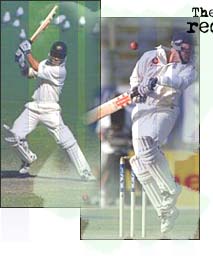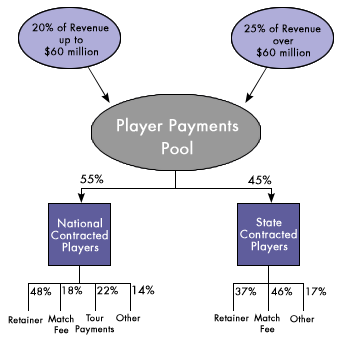
 January 11, 2001
January 11, 2001Money Tree
Prem PanickerThe players want contracts. Sections of the board do, others don't. Funnily enough, though, while the players have been putting some thought into the question, the board's reactions have depended more on personal prejudices and internal politics rather than on thought and analysis.
Any application of thought would need to begin with the question -- why? Why does a contract make sense? To answer this, look first at the existing situation in India today. Despite the success -- financial success, that is -- of the Tendulkars and the Dravids and Gangulys, cricket is not seen as a lucrative sport.
To play in the leagues of the various states (and remember, this is where the state gets its talent pool), you have to spend money from your own pocket. When you get to the state level, the situation is no better -- a player who figures in a Ranji Trophy game gets approximately Rs 3000. Rs three thousand? Would you, assuming you had a reasonable level of intelligence, think seriously of a career where you are paid that amount for four days of hard labour? Not to mention one wherein you are made to feel like a beggar at a traffic light, by the authorities? Because, not to mince words, that is precisely how the players are treated. If, to cite one instance, you are travelling from say Chennai to Mumbai to play in a Ranji fixture, you have to pay for your ticket out of your own pocket. Once the match is over, you then have to produce a bill, attaching your ticket, certifying that you play for your state, certifying that you travelled to play a Ranji fixture, and submit it to the BCCI -- which will then reimburse you the travel expenses, as and when it feels like.
This is the existing situation. It is also the reason why today, when a youngster decides to focus on his cricket, the decision leads to a domestic upheavel, with his parents telling him not to be a fool, and ordering him to focus on his studies instead.
Not so long ago, there was a time when you could persuade your parents to let you play. By arguing that if you could develop your cricketing skills and attain a certain standard, you were sure to get employment in some bank or private company. So, the youngster could -- and would -- argue, I get a job, I get to play cricket, and if fortune is kind and I keep improving my own standard of play, I could get to play for the state and, touch wood, the country. And the day I get my country cap, the likes of Pepsi will line up at my doorstep, asking for my signature on the contract form -- ask Zahir Khan, to name one instance.
But not any more. Increasingly, banks and private companies are cutting down on hiring cricketers. The reason is twofold -- league cricket does not give you any publicity mileage any more, so what is the point in spending a lot of money to build a strong league team? And secondly, hiring 14 guys to do nothing but play goes against today's corporate ethos, which is to pare employment rolls down to the absolute minimum, and look for quality as opposed to numbers in the workforce.
As a national player pointed out, India draws its cricketers from the ranks of the middle class, NOT the rich. And the middle class mindset inclines towards completing your education, then looking for a job that guarantees you a certain level of security.
Cricket, today, does not hold out any such guarantees. And if this situation persists, if the game fails to attract young acolytes, then India will go the West Indies way.
So how is cricket to be made attractive to the middle class? Simple -- by transforming it into a viable career option. And at this point, it needs mentioning that merely giving contracts to national players will not achieve that objective -- the reforms will need to start from the bottom up.
So what shape should the reforms consist of? At this stage, we'll take a
little detour, to present a financial model in graphic form. 
The overall model is very simple -- the sort of simple, effective structure that argues an enormous amount of thought, of fine-tuning.
Every year, a certain percentage of income is paid into a player payment pool. As you can see from the graphic, the percentage of income that the players get to share is structured in such a way that there is a base figure, of 20 per cent. If the earnings exceed, in this model, the $60 million mark, then the percentage for the players is also increased. What this does is, it tells the players, straight out, that the more Indian cricket earns, the more they also get.
The money tree presented here in graphic form is pretty much self-explanatory. It is not our own -- this, in fact, is the Australian model.
The overall thinking is relevant for us as well. However, an element of fine-tuning is necessary to take into account conditions in India.
So -- what is a good structure? How can the reforms be structured, so that cricket becomes, for the majority of people in this country, an attractive career option? We will attempt, in tomorrow's edition of the diary, to explain our thinking.
Meanwhile, do let us know your thoughts.... and stay smiling....
Design: Devyani Chandwarkar
Related Links:
Terms of endearment
Of the players, by the players...
The Rediff Email Diary -- the complete archives
![]()
![]()
©1996 to 2001 rediff.com India Limited. All Rights Reserved.